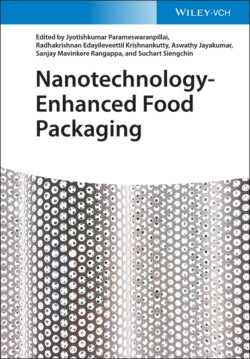Читать книгу Nanotechnology-Enhanced Food Packaging - Группа авторов - Страница 43
2.2.6 Starch and Derivatives
ОглавлениеStarch is a carbohydrate, considered one of the most abundant polysaccharides in the world. This macromolecule is in the form of granules that are synthesized after the polymerization of glucose in plant [118]. Starch is composed of amylose and amylopectin [119]. Amylose is formed by glucose units linked by α-(1,4), containing sparing α-(1,6) branch points (∼1%). This macromolecule has a linear structure, and it contributes mainly to the amorphous phase of the starch granule, whereas amylopectin is a branched biopolymer formed by α-(1,4) glucose, highly branched by means of α-(1,6) glucose links (∼5%). This macromolecule is responsible by the crystalline structure in starch granules [120].
Starch can be isolated from different botanical sources including cereals (corn, wheat, rice, and sorghum), vegetables (pea, chickpeas, and lentils), and tubers (cassava, potato, sweet potato, and yam). Due to the overall structure of starch, botanical sources, climate conditions, geographic location for cultivation, and soil type, the ratio of amylose to amylopectin is variable [118].
Films and coatings based on starch are extensively studied due to its abundance, low cost, and excellent film-forming properties. Furthermore, starch-based films are transparent, odorless, tasteless, and good gas barrier. Hence, films and coatings based on starch have been used to extend the shelf life of fruits (Table 2.6) [120, 127]. The physical properties of starch-based materials are impacted by the starch source, manufacture time and temperature, type of plasticizer, co-biopolymers, and storage conditions [120].
The molecular weight, amylopectin/amylose ratio, and crystalline fraction (15–45%) depend on the botanical source of starch, modifying the physicochemical properties of films and coatings based on this macromolecule [128]. A higher proportion of amylopectin in the starch granules leads to manufacturing films with lower water solubility. Unfortunately, starch-based materials have poor mechanical and gas barrier properties. Aiming to improve the mechanical and barrier properties of starch-based materials, some researchers have studied the addition of different plasticizers, solvents, and macromolecules. Also, other natural compounds such as fatty acids, natural plant extracts (green tea, pomegranate), organic compounds, and essential oils have been investigated, aiming the manufacture of starch-based materials with antimicrobial activity [120, 129]. Another alternative is to blend the starch with other biopolymers such as gelatin, guar gum, and chitosan (Table 2.6) [121, 130, 131]. Thus, the interactions among biopolymer improve the mechanical and barrier properties in starch films [120]. Finally, fatty acids can be added in starch-based materials to reduce the water sensibility in these materials; however, fatty acids could induce phase separation and reduce the mechanical properties in films and coatings [132].
